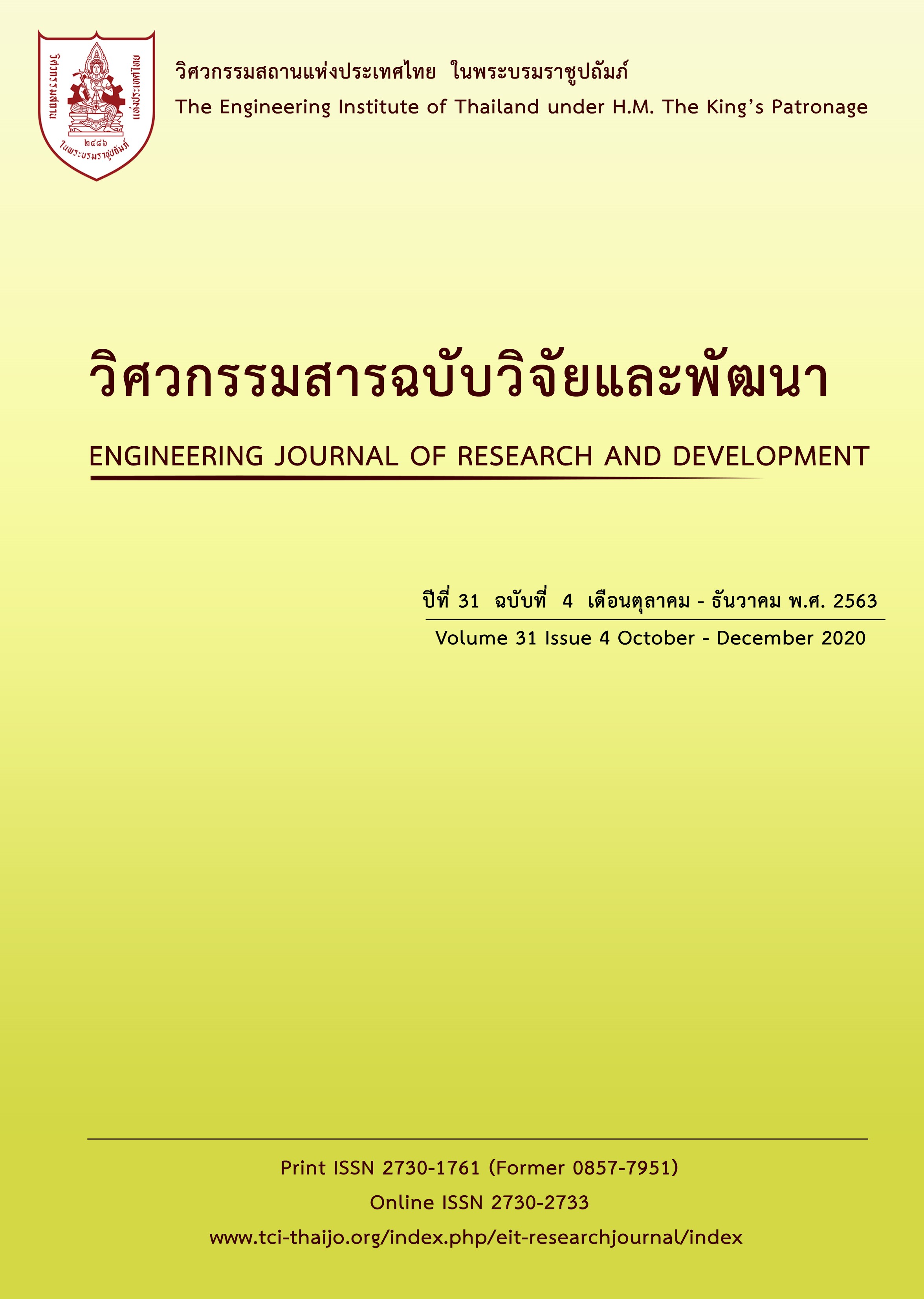EARTHQUAKE EFFECT TO LIQUEFACTION POTENTIAL IN PHAYAO PROVINCE
Main Article Content
Abstract
The purpose of this research is to study the earthquake effect to liquefaction potential in Phayao Province, measuring 6.3 Mw, on May 5th, 2014 in Dongmada, Mae Laos, Chiang Rai. The PGA was recorded for 0.6772 m/s2 at Phayao monitoring stations. The study uses simplified method by Seed and Idriss (1971) and revised edition by Idriss and Boulanger (2008). The analyzation considered by results of 15 boring logs in the area of high building and Phayao’s ancient remains. The research concluded that in Muang Phayao District zone with 5 boring logs by Seed and Idriss (1971) result showed the range of the factor of safety is 2.96- 6.03, Idriss and Boulanger (2008) is 2.60-5.30. In University of Phayao zone with 10 boring logs by Seed and Idriss (1971) result showed the range of the factor of safety is 2.02-13.06, Idriss and Boulanger (2008) is 2.60-20.56 both area has sufficient FS for resistance of the liquefaction. The probabilistic of liquefaction in Phayao, PL shows as 5.03% with Seed and Idriss (1971) and 2.30% with Idriss and Boulanger (2008). Liquefaction would not be occurred in both zones which are in the range of almost certain. When we plot the graph to compare FS with PL, the factor of safety is high which reflects low probability
Article Details
The published articles are copyright of the Engineering Journal of Research and Development, The Engineering Institute of Thailand Under H.M. The King's Patronage (EIT).
References
earthquakestat.html
[2] สำนักเฝ้าระวังแผ่นดินไหว กรมอุตุนิยมวิทยา. รายงานแผ่นดินไหวบริเวณจังหวัดเชียงราย, จากเอกสารวิชาการเลขที่ 550.341-01-2014, 2557.
[3] วิกิพีเดีย สารานุกรมเสรี, 7 สิงหาคม 2557. จังหวัดพะเยา. สืบค้นเมื่อ 10 มกราคม 2562, จาก https://th.wikipedia.org/wiki/จังหวัดพะเยา
[4] สุคนธ์เมธ จิตรมหันตกุล. รอยเลื่อนมีพลังในประเทศไทย. (ธันวาคม 2556). สืบค้นเมื่อ 5 มกราคม 2562, จาก http://www.geothai.net/thailand
[5] Seed, H. B. and Idriss, I. M. Simplified Procedure for Evaluating Soil Liquefaction Potential. J.Soil Mechanics And Foundations Div., 1971. ASCE 97(SM9), 1249–
1273
[6] จิตนันท์ กาวิละนันท์ และเศรษฐพงศ์ เศรษฐบุปผา. เงื่อนไขในการเกิดสภาวะดินเหลวและทรายพุ ที่บ้านทุ่งฟ้าผ่า อ.แม่สรวย จ.เชียงราย ในเหตุการณ์แผ่นดินไหว วันที่ 5 พฤษภาคม 2557.
ใน เอกสารประกอบการประชุมวิชาการวิศวกรรมโยธาแห่งชาติครั้งที่ 21. สงขลา: วิศวกรรมสถานแห่งประเทศไทย., (28-30 มิถุนายน 2559).
[7] บุญชัย อุกฤษฏชน และธวัชชัย สังขะวิไล. การวิเคราะห์โอกาสการเกิด Liquefaction สำหรับชั้นทรายกรุงเทพฯ ชั้นแรก. ใน เอกสารประกอบการประชุมวิชาการวิศวกรรมโยธาแห่งชาติครั้งที่
9. เพชรบุรี: วิศวกรรมสถานแห่งประเทศไทย.(19-21 พฤษภาคม 2547).
[8] ภัทรมน วงศ์ราษฎร์ ธเนศ ทองเดชศรี ธนกร ชมภูรัตน์ และ ปรีดา ไชยมหาวัน. การศึกษาผลของแผ่นดินไหวที่มีต่อโอกาสการเกิดลิควิแฟกชันของจังหวัดพะเยา. ใน เอกสารประกอบการ
ประชุมวิชาการวิศวกรรมโยธาแห่งชาติครั้งที่ 21. จ.สงขลา : วิศวกรรมสถานแห่งประเทศไทย. (28-30 มิถุนายน 2559).
[9] Mase L.Z., Likitlersuang, S. and Tobita, T. “Non-linear Site Response Analysis of Soil Sites in Northern Thailand during the Mw 6.8 Tarlay Earthquake”
Engineering Journal, 2018, Vol. 22, No. 3, pp. 291-303, May 2018. DOI:10.4186/
[10] Mase L.Z., Likitlersuang, S. and Tobita, T. “Analysis of seismic ground response caused during strong earthquake in Northern Thailand” Soil Dynamic and
Earthquake Engineering, 2018, Vol. 114, November 2018, pp. 113-126. DOI: 10.1016/j.soildyn.2018.07.006
[11] Mase L.Z., Likitlersuang, S. and Tobita, T. “Cyclic Behaviour and Liquefaction Resistance of Izumio Sands in Osaka, Japan” Marine Georesources and
Geotechnology, 2019, Vol. 37, No. 7, pp. 765 – 774. DOI:10.1080/1064119X.2018.1485793
[12] Likitlersuang, S., Plengsiri, P., Mase, L.Z. and Tanapalungkorn, W. “Influence of spatial variability of ground on seismic response analysis: a case study of
Bangkok subsoils” Bulletin of Engineering Geology and the Environment, 2019, (Online) DOI:10.1007/s10064-019-01560-9
[13] Soksan, T., Likitlersuang, S. and Pipatpongsa, T. “Monotonic and Cyclic Behavior of Chiang Mai Sand under Simple Shear Mode”, Geotechnical and Geological
Engineering, 2013, Vol. 31, No. 1, pp 67 – 82. DOI:10.1007/s10706-012-9563-9
[14] วีรเดช ธนพลังกร. โอกาสเกิดทรายเหลวเนื่องจากแผ่นดินไหวในพื้นที่ภาคเหนือของประเทศไทย. วิทยานิพนธ์ วศ.ม., จุฬาลงกรณ์มหาวิทยาลัย, กรุงเทพฯ., 2557.
[15] ภัทรมน วงศ์ราษฎร์. ผลของแผ่นดินไหวที่มีต่อโอกาสในการเกิดลิควิแฟกชันและกราฟสเปกตรัมตอบสนอง ของจังหวัดพะเยา. วิทยานิพนธ์ วศ.ม., มหาวิทยาลัยพะเยา, พะเยา., 2562.
[16] Idriss, I. M. and Boulanger R. W. Soil liquefaction during earthquakes, California: Earthquake Engineering Research Institute Oakland., 2008.
[17] Idriss, I. M. and Boulanger, R.W. SPT-BASED Liquefaction Triggering. California: Department of Civil & Environmental Engineering college of Engineering,
University of California at Davis, 2010.
[18] สุทธิศักดิ์ ศรลัมพ์ และเจษฎา เฟื่องอักษร.Probabilistic Analysis of Liquefaction Potential: The First Eyewitness Case In Thailand. ใน เอกสารประกอบ การประชุมวิชาการ
วิศวกรรมโยธาแห่งชาติครั้งที่ 18. (8-10 พฤษภาคม 2556), เชียงใหม่: วิศวกรรมสถานแห่งประเทศไทย.
[19] Samson, S. C. Liao., Daniele, Veneziano., and Robert, V. Whitman. Regression models for evaluating liquefaction probability. J.Geotech. Eng, 1988, 389-411.


